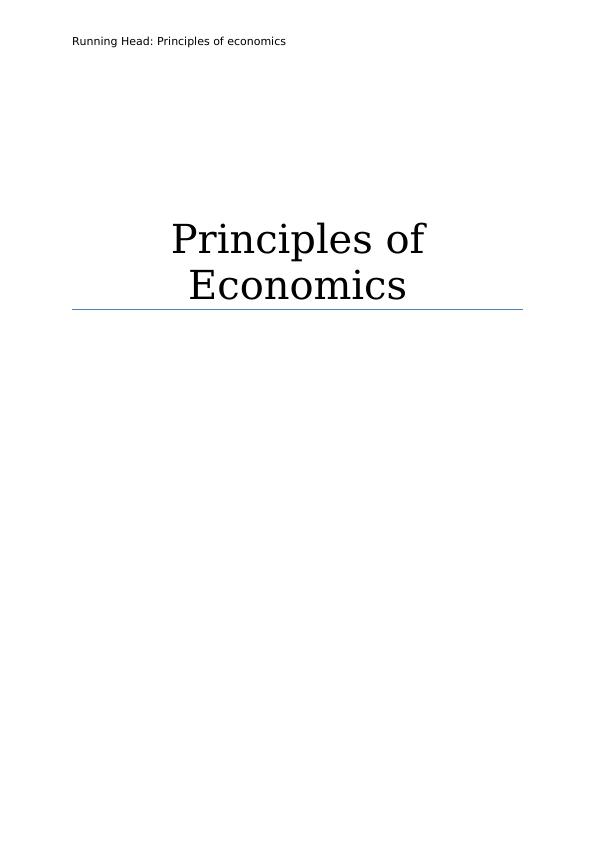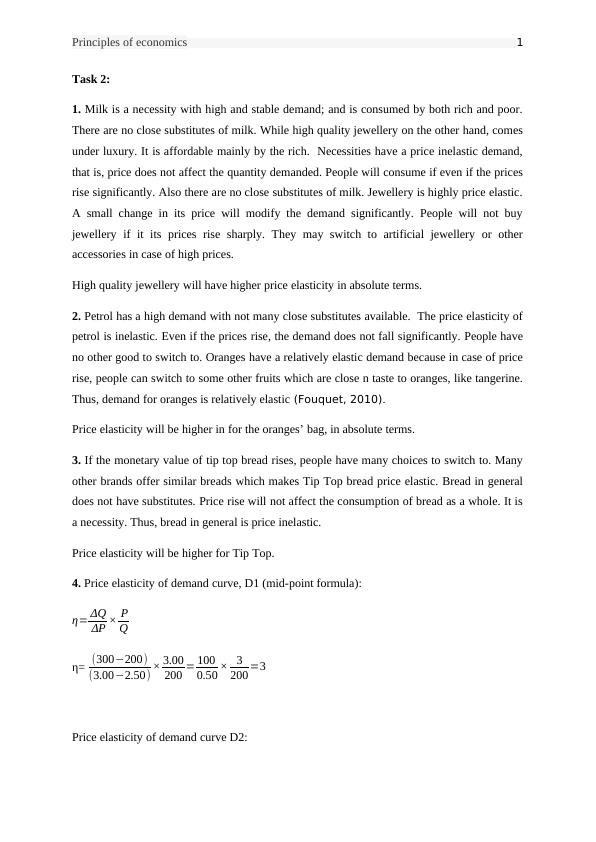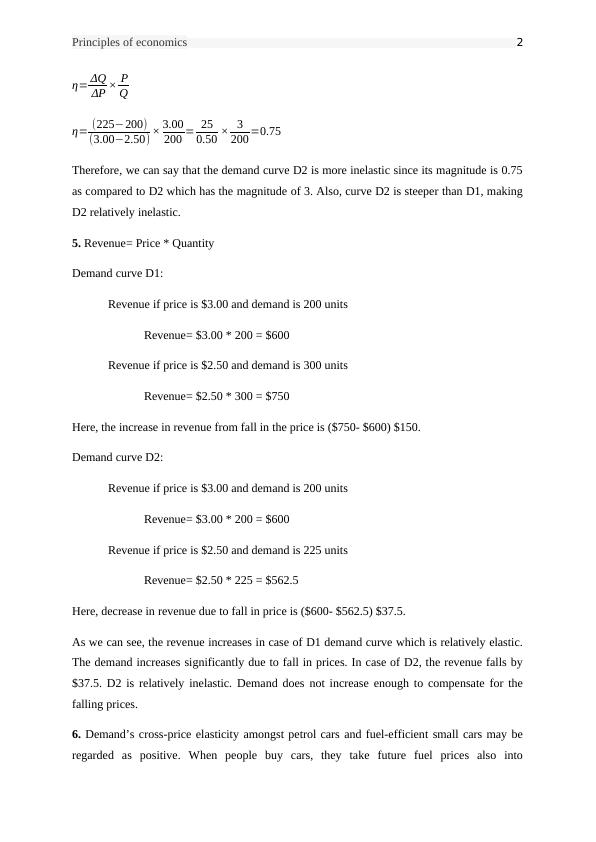Principles of Economics 9 Running Head: Principles of Economics
Added on 2021-04-24
11 Pages3013 Words124 Views
Running Head: Principles of economics
Principles of
Economics
Principles of
Economics

Principles of economics 1
Task 2:
1. Milk is a necessity with high and stable demand; and is consumed by both rich and poor.
There are no close substitutes of milk. While high quality jewellery on the other hand, comes
under luxury. It is affordable mainly by the rich. Necessities have a price inelastic demand,
that is, price does not affect the quantity demanded. People will consume if even if the prices
rise significantly. Also there are no close substitutes of milk. Jewellery is highly price elastic.
A small change in its price will modify the demand significantly. People will not buy
jewellery if it its prices rise sharply. They may switch to artificial jewellery or other
accessories in case of high prices.
High quality jewellery will have higher price elasticity in absolute terms.
2. Petrol has a high demand with not many close substitutes available. The price elasticity of
petrol is inelastic. Even if the prices rise, the demand does not fall significantly. People have
no other good to switch to. Oranges have a relatively elastic demand because in case of price
rise, people can switch to some other fruits which are close n taste to oranges, like tangerine.
Thus, demand for oranges is relatively elastic (Fouquet, 2010).
Price elasticity will be higher in for the oranges’ bag, in absolute terms.
3. If the monetary value of tip top bread rises, people have many choices to switch to. Many
other brands offer similar breads which makes Tip Top bread price elastic. Bread in general
does not have substitutes. Price rise will not affect the consumption of bread as a whole. It is
a necessity. Thus, bread in general is price inelastic.
Price elasticity will be higher for Tip Top.
4. Price elasticity of demand curve, D1 (mid-point formula):
η= ΔQ
ΔP × P
Q
η= (300−200)
(3.00−2.50) × 3.00
200 = 100
0.50 × 3
200 =3
Price elasticity of demand curve D2:
Task 2:
1. Milk is a necessity with high and stable demand; and is consumed by both rich and poor.
There are no close substitutes of milk. While high quality jewellery on the other hand, comes
under luxury. It is affordable mainly by the rich. Necessities have a price inelastic demand,
that is, price does not affect the quantity demanded. People will consume if even if the prices
rise significantly. Also there are no close substitutes of milk. Jewellery is highly price elastic.
A small change in its price will modify the demand significantly. People will not buy
jewellery if it its prices rise sharply. They may switch to artificial jewellery or other
accessories in case of high prices.
High quality jewellery will have higher price elasticity in absolute terms.
2. Petrol has a high demand with not many close substitutes available. The price elasticity of
petrol is inelastic. Even if the prices rise, the demand does not fall significantly. People have
no other good to switch to. Oranges have a relatively elastic demand because in case of price
rise, people can switch to some other fruits which are close n taste to oranges, like tangerine.
Thus, demand for oranges is relatively elastic (Fouquet, 2010).
Price elasticity will be higher in for the oranges’ bag, in absolute terms.
3. If the monetary value of tip top bread rises, people have many choices to switch to. Many
other brands offer similar breads which makes Tip Top bread price elastic. Bread in general
does not have substitutes. Price rise will not affect the consumption of bread as a whole. It is
a necessity. Thus, bread in general is price inelastic.
Price elasticity will be higher for Tip Top.
4. Price elasticity of demand curve, D1 (mid-point formula):
η= ΔQ
ΔP × P
Q
η= (300−200)
(3.00−2.50) × 3.00
200 = 100
0.50 × 3
200 =3
Price elasticity of demand curve D2:

Principles of economics 2
η= ΔQ
ΔP × P
Q
η= (225−200)
(3.00−2.50) × 3.00
200 = 25
0.50 × 3
200 =0.75
Therefore, we can say that the demand curve D2 is more inelastic since its magnitude is 0.75
as compared to D2 which has the magnitude of 3. Also, curve D2 is steeper than D1, making
D2 relatively inelastic.
5. Revenue= Price * Quantity
Demand curve D1:
Revenue if price is $3.00 and demand is 200 units
Revenue= $3.00 * 200 = $600
Revenue if price is $2.50 and demand is 300 units
Revenue= $2.50 * 300 = $750
Here, the increase in revenue from fall in the price is ($750- $600) $150.
Demand curve D2:
Revenue if price is $3.00 and demand is 200 units
Revenue= $3.00 * 200 = $600
Revenue if price is $2.50 and demand is 225 units
Revenue= $2.50 * 225 = $562.5
Here, decrease in revenue due to fall in price is ($600- $562.5) $37.5.
As we can see, the revenue increases in case of D1 demand curve which is relatively elastic.
The demand increases significantly due to fall in prices. In case of D2, the revenue falls by
$37.5. D2 is relatively inelastic. Demand does not increase enough to compensate for the
falling prices.
6. Demand’s cross-price elasticity amongst petrol cars and fuel-efficient small cars may be
regarded as positive. When people buy cars, they take future fuel prices also into
η= ΔQ
ΔP × P
Q
η= (225−200)
(3.00−2.50) × 3.00
200 = 25
0.50 × 3
200 =0.75
Therefore, we can say that the demand curve D2 is more inelastic since its magnitude is 0.75
as compared to D2 which has the magnitude of 3. Also, curve D2 is steeper than D1, making
D2 relatively inelastic.
5. Revenue= Price * Quantity
Demand curve D1:
Revenue if price is $3.00 and demand is 200 units
Revenue= $3.00 * 200 = $600
Revenue if price is $2.50 and demand is 300 units
Revenue= $2.50 * 300 = $750
Here, the increase in revenue from fall in the price is ($750- $600) $150.
Demand curve D2:
Revenue if price is $3.00 and demand is 200 units
Revenue= $3.00 * 200 = $600
Revenue if price is $2.50 and demand is 225 units
Revenue= $2.50 * 225 = $562.5
Here, decrease in revenue due to fall in price is ($600- $562.5) $37.5.
As we can see, the revenue increases in case of D1 demand curve which is relatively elastic.
The demand increases significantly due to fall in prices. In case of D2, the revenue falls by
$37.5. D2 is relatively inelastic. Demand does not increase enough to compensate for the
falling prices.
6. Demand’s cross-price elasticity amongst petrol cars and fuel-efficient small cars may be
regarded as positive. When people buy cars, they take future fuel prices also into

Principles of economics 3
consideration. If they expect the future prices of petrol to be higher, they will tend to buy
fuel-efficient cars. Thus, the demand for fuel-efficient cars will increase in case of increase in
prices of petrol. Less fuel-efficient cars like SUVs will have negative cross price elasticity
with petrol. If the prices of petrol will rise, people will tend to buy fuel-efficient cars and thus
increasing the demand for fuel-efficient cars.
7. Due to the cyclone, the crops were damaged and there was sharp decline the supply of the
bananas, shifting the supply curve backwards. The shift is not up to the extent of the crops
damaged but a little less since some bananas were imported. There will be no change in the
demand. The demand was relatively elastic while the supply was inelastic. Increased prices
were an incentive for the producers to supply more but it will take time. Also, there were
restrictions to trade.
Figure 1: Cyclone changes the supply and its elasticity. The price increases from P to P’ and
quantity decreases from Q to Q’.
Pric
consideration. If they expect the future prices of petrol to be higher, they will tend to buy
fuel-efficient cars. Thus, the demand for fuel-efficient cars will increase in case of increase in
prices of petrol. Less fuel-efficient cars like SUVs will have negative cross price elasticity
with petrol. If the prices of petrol will rise, people will tend to buy fuel-efficient cars and thus
increasing the demand for fuel-efficient cars.
7. Due to the cyclone, the crops were damaged and there was sharp decline the supply of the
bananas, shifting the supply curve backwards. The shift is not up to the extent of the crops
damaged but a little less since some bananas were imported. There will be no change in the
demand. The demand was relatively elastic while the supply was inelastic. Increased prices
were an incentive for the producers to supply more but it will take time. Also, there were
restrictions to trade.
Figure 1: Cyclone changes the supply and its elasticity. The price increases from P to P’ and
quantity decreases from Q to Q’.
Pric

End of preview
Want to access all the pages? Upload your documents or become a member.
Related Documents
Price Elasticity in the UKlg...
|20
|3407
|54
Assignment on Economic Principleslg...
|8
|654
|81
HECON - Economics Assignment | Concept Of Demandlg...
|5
|654
|196
